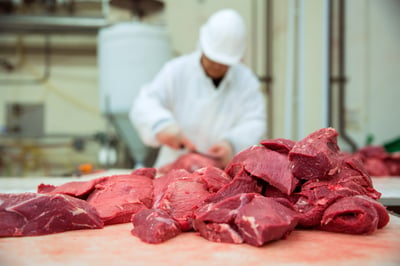 For any product inspection system, it’s important to spot and eliminate contaminants. However, there’s far more that goes into quality control than just preventing contamination—especially in meat production.
For any product inspection system, it’s important to spot and eliminate contaminants. However, there’s far more that goes into quality control than just preventing contamination—especially in meat production.
To really maximize quality control, you need to be able to check your raw meat products for factors such as their fat content (a.k.a. Chemical Lean or CL). The trouble is, traditional, lab-based testing methods for checking fat content are slow, destructive, and prone to sample bias.
What’s sample bias? It’s the tendency for an inaccurate assessment of something because of a limited sample size. For example, you’d only be testing about 0.0001% of the meat in a traditional Soxhlet test, so the fat content of the sample might not match the rest of the meat.
This is where in-line fat analysis x-ray systems become invaluable to meat producers looking to maximize their quality control.
How X-Ray Inspection and Fat Analysis Maximizes Quality AND Productivity
Not just any x-ray system will work for analyzing CL in meat. To be useful for fat analysis, the x-ray inspection machine needs to be able to analyze materials based on their chemical composition—a feature that standard, single-emitter x-ray machines lack. DEXA X-ray systems can also provide moisture and protein calculation simultaneously.
Dual Energy X-ray Absorptiometry (DEXA) machines use two x-ray emitters to examine meat as it passes through the production line. This allows DEXA systems to check the chemical composition of meat and assess what percentage of the meat is lean vs how much is fat.
Because this process is near-instantaneous, it allows for a thorough analysis of every last ounce of meat on the production line without causing a significant slowdown. Also, as a nondestructive test, no product is lost to the testing process.
Knowing the exact amount of fat content for each ounce of product allows for unprecedented control over your meat-based packages and recipe formulations.
For example, you could label each package of meat with the fat content that most closely resembles the package’s actual contents. Or, you could mix above-target and below-target meat packages to achieve more consistent fat content for your recipe formulations.
While DEXA x-ray systems are verifying the fat content of raw meat products, they can also provide simultaneous detection for contaminants. This allows you to maximize your product’s safety without a needed a separate inspection station.
Just How Fast is DEXA Inspection?
Modern DEXA machines can analyze roughly 160 tons of meat per hour without sacrificing accuracy.
How Accurate is DEXA Analysis at Reading CL Values?
A DEXA analysis of chemical lean is accurate to within 0.5% - 1% of the actual fat content of the meat being sampled. Just to compare, traditional, lab-based Soxhlet tests are accurate to within 2-6% when factoring sampling error.
DEXA fat analysis of meat is faster, easier, more accurate, and more thorough than traditional, lab-based tests. It’s little wonder that meat producers across the country are switching to using x-ray inspection technology for checking fat content of their meat products.
Integrating an inline meat inspection machine from industry leaders like Eagle PI is easier than you might think! Find out more today!




